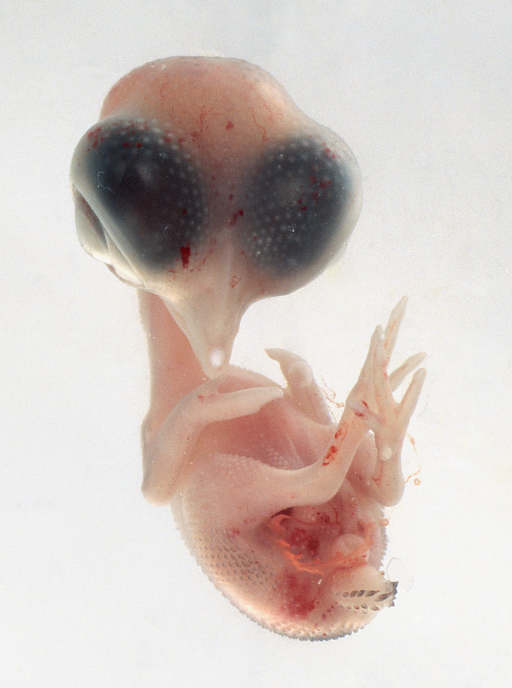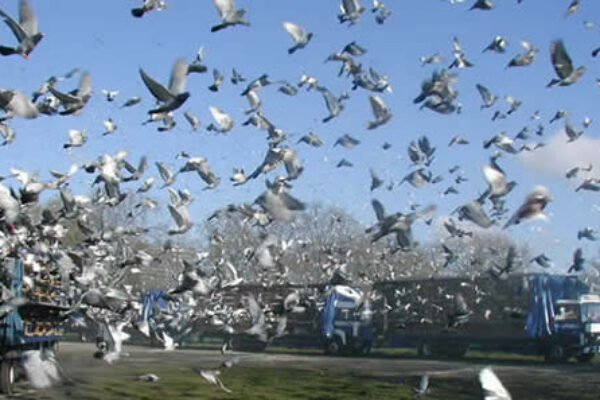Embryonic Death in Racing Pigeons
 The normal rate of embryonic death in the incubating eggs of racing pigeons is about 5%. If you are dealing with a death rate above that, you need to investigate possible causes of why the fertile eggs are failing to hatch. Many fanciers think that salmonella is the cause but this infection actually accounts for less than 5% of in-shell deaths. In this article, we will study the possible causes of egg death through the various stages of incubation.
The normal rate of embryonic death in the incubating eggs of racing pigeons is about 5%. If you are dealing with a death rate above that, you need to investigate possible causes of why the fertile eggs are failing to hatch. Many fanciers think that salmonella is the cause but this infection actually accounts for less than 5% of in-shell deaths. In this article, we will study the possible causes of egg death through the various stages of incubation.
Pigeon egg death can occur within three different phases of embryonic development:
- During the first few days of incubation
- During the growth phase from Day 4 to Day 14
- Just prior to or during the hatching phase
We will look at each of the phases in detail as to the possible causes of embryonic death.
Phase 1: Death with the First Few Days of Incubation
Generally, there are three causes of death during this initial phase—inadequate temperatures, injuries to the chick or the yolk and genetic issues.
Genetic Anomalies
Genetic anomalies incompatible with life are one cause of early embryonic death. This would be diagnosed with an egg autopsy. Genetic anomalies may be the result of poor breeders or malnutrition in the breeder hen in the months prior to egg production. The age of the hen may also be a factor.
Embryonic Injuries
Throughout incubation, the pigeon embryo is quite sensitive to vibrations. Jarring of the egg and other excessive vibration can result in injury and death to the embryo. Poor parenting, too many birds in one section or ‘over interference’ by the fancier can cause result in fatal injuries to the embryo.
Improper Temperatures
Temperatures that are too hot or too cold can cause embryonic death, as can poor ventilation. Improper nesting materials or a poor nest box design can factor into this.
Phase 2: Death from Day 4 to Day 14
Malnutrition
During this phase of the incubation, the chick is growing. Though this is the longest phase in egg incubation, this accounts for the fewest deaths. The biggest factor in death during this time is malnutrition. Nutritional problems in the hen for months up to the point of egg-laying lessen the rate of survival for the developing chick.
Infection
Infection can be another cause and can be transmitted to the chick in basically two ways. The first is through the hen itself. The bacteria Chlamydia or Salmonella can infect the ovary and then be passed onto the embryo, either during the egg formation or as it travels through the oviduct.
Infection can also be transmitted via contamination through the egg shell. This is really related to the health of the hen. Poor egg shell development is typically the result of a calcium deficiency in the hen. The eggshell may be cracked, thin, rough or misshapen. An early sign of calcium deficiency within the hen is the passing of eggs that exhibit translucent, clear lines around the outside of the eggs. These develop as the egg is passing through the oviduct.
Phase 3: Death during the Hatching Phase
If death occurs during the last few days of the incubation, it is usually the result of problems with hatching. To best understand this, it is necessary to understand the process that occurs during hatching.
As the chick prepares to hatch, it needs to shift from getting its air supplied from the chorioallantois, or surrounding membrane, to breathing air outside of this membrane. This shift in respiration occurs in two stages.
First, the chick internally pips, cutting a small hole into the air chamber at the end of the egg and breathes that air. Then, twelve to twenty-four hours later, the chick cracks through the shell and breathes the external air.
Also, during this time, the chick drinks the amniotic fluid and is re-absorbing the last of the yolk sac, drawing the sac up into the navel, creating the Merkel’s diverticulum. Through drinking the amniotic fluid and through the yolk sac, the chick gets antibodies which protect it from infection during the first few weeks of life.
Temperature and Humidity during this Phase
Improper temperature and humidity can interfere with the hatching process and result in chick death. Primarily is the temperature is too high or the humidity is too low, the shell and shell membrane becomes hard and dry, making it difficult for the chick to hatch. The chick becomes exhausted and dehydrated. Chick dehydration at this time is referred to as “sticky chick”. Chicks are partially hatched and found dead, stuck to the dry shell membranes.
To prevent death during the hatching phase, ensure that the nesting box has a temperature range of 20 to 25 (C) and a humidity of 70%. Also, provide the stock hens with rain or a bath. If this is not possible, gently mist both the underside of the hen and the eggs with a spray bottle.
Measures to Improve Chick Hatchability
To summarize, here are some steps you can take to improve your chicks’ hatchability:
- Superior stock bird nutrition in the months prior to breeding
- Provide a fresh nest bowl for every round of eggs
- Ongoing nest bowl hygiene with adequate control of nest bowl mites and pigeon flies
- Proper climatic control of the nesting box
- Access to rain or a bath during the hatching phase
If these fail to lessen the failure of incubating egg death in your racing pigeons, contact your avian veterinarian who can either test your hens for infection or perform an egg autopsy.









Thanks Chris for a great article
Thanks it just show that good health is so vital in our sport
Hey chris,
it’s a essential article for every pigeon lover & you did it very well by wrote down this kind of article.keep it up.
Hi Chris this was a very good article keep up the good work Brad.
Not much I can say besides – Great information … like always !! ~ Mike ~
Hi there,
Could I translate this article into Chinese and post it on my blog?
A few years ago I was losing young at 1 day – 10 days old. I thought that was paratyphoid. Turned out to be that the nest pads that I was using that years was the culprit. Something in the pads were causing the young to die. After I quit using the pads and went to tobbaco stems I never lost anymore young at all. Goes to show that it is not always a disease causing the problem.
Also giving the breeders a bath once a week will help,or see video @ glemserloft.com. The eggs need moisture to hatch. Keep the breeders in top shape, the breeders are the key to winning. Give the best feed and the best medication ,minerals, grit. It is never too cold to give them bath. If your breeders get worn down from raising babies, something is wrong. It was a very nice article .
CHRIS;Enjoy your articles, very informative ,keep up the good job.CHARLIE BARBIERE